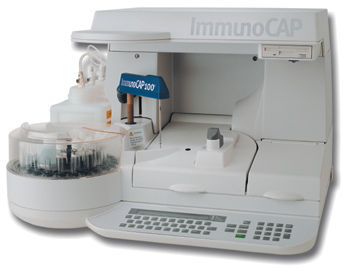How Is Allergy Diagnosed?
There are many factors involved in an accurate allergy diagnosis and an effective treatment/management plan.
Two key steps in the process of allergy diagnosis are the medical history and allergy test selection. When it comes to human allergic disease, an individual’s medical history is as important as the results of an allergy test. Medical history is the critical link between allergy test results and allergic disease itself. Performing any allergy test where a good medical history has not been taken can be of minimum clinical use.
There are a range of questions that should be raised, such as is there any family history of allergy, when do symptoms occur (time of day, seasonal), where do symptoms occur (at home, work, school), are pets in the household or any other environment the sufferer visits, what type of work, conditions at home (damp, mouldy), does diet have an effect. The answers to these and other questions should give a guide to what the relevant allergens are before embarking on any test.
What is a skin prick test?

Skin prick tests for measuring mast cell bound specific antibodies in allergic disorders have been around since the 1860s. Today, prick tests are commonly used by allergists as allergy diagnosis aids. These tests are not very invasive are safe and, for most allergens, they tend to produce quick results. If the results of a skin test are negative, they may be followed by intradermal tests, which give allergists more details about what’s causing the underlying symptoms.
Allergens for testing are selected based on a carefully taken case history. These allergens are in solution, with a small drop being placed on to the skin (usually the inner forearm). A lancet with a small point is pricked through the drop of allergen (separate lancet for each test). If done correctly the process is completely painless. Results are read after about 15 minutes A positive result is a red wheal with an associated larger flare. In addition to the allergens tested, two controls must be performed, a solution of the diluent used (negative control) and histamine solution (positive control). The negative control should not cause a reaction (if a reaction occurs it is a sign of dermagraphism which should be considered when interpreting results) and the histamine should always react.
The resulting wheal diameter is measured and recorded. One of the best ways of recording the results is to draw around the wheal in biro and lifting this off with magic tape, which can placed on to millimetre square graph paper – a permanent record.
In most cases, the skin prick test is reliable, it is important to note however, certain medications must be withdrawn for several days before the test is performed. This would include antihistamines and steroid creams/ointments, which will have a dampening effect. In very young patients, skin prick testing may not work as allergy antibodies may not be present in the skin cells.
There is a question mark on the reliability on the allergens used for skin prick test. In some cases there is poor standardisation (different between manufacturers), level of relevant allergen low, interfering contaminants and in the case of mould and food allergens there is generally poor quality.
Further details can be seen on the American College of Allergy and Clinical Immunology link below.
http://acaai.org/allergies/treatment/allergy-testing/skin-test
What is an Allergy Blood Test?
Allergic individuals produce specific antibodies, immunoglobulin E (IgE). This IgE antibody, which was only discovered in the 1960’s, is produced after exposure to an allergen in susceptible people. Each allergen causes an allergen specific IgE to be produced. These antibodies circulate in the blood stream, they then bind to Mast cells. Once bound, the IgE is active and on repeated exposure to the relevant allergen, a bonding takes place. When this happens, the Mast cell breaks down and releases chemicals such as histamine. It is these circulating antibodies that are measured in the laboratory.
There are various allergy blood tests available, the best known being ImmunoCAP (also incorrectly referred to as CAP-RAST). All of these tests require a blood sample, some from venepuncture, others from a finger prick. The time taken by different tests can be minutes to hours.
The major advantages of allergy blood tests are, no requirement to stop medication, skin reactivity irrelevant, not age dependent, large range of allergens, semi-quantitative results and have no risk. The drawbacks are the relatively high cost of reagents and the wait for results (which can be weeks).

ImmunoCAP
What other allergy tests are available?
There are two groups of allergy diagnosis tests available, those that are clinically validated and those still not shown to work.
In the first group the majority of remaining tests are known as challenge tests (nasal, bronchial, conjunctival and food). Small amounts of allergen are introduced into relevant organ and any symptoms are recorded. These challenge tests are only performed in specialist clinics. Although reliable, they can initiate serious reactions. In food allergy suspected cases, as well as challenge tests, diagnosis can include elimination diets (remove foods from diet) and exclusion diets (suspected and commonly encountered food allergens excluded and slowly re-introduced).
The second group includes the neutralisation test, cytotoxic tests on blood cells, Vega testing, applied kinesiology and specific IgG antibody testing. Until these have been clinically validated and peer reviewed they are not recommended for allergy diagnosis